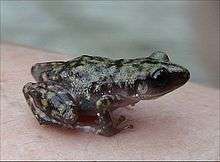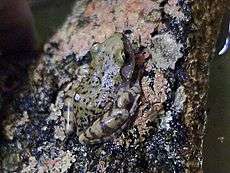Cliff chirping frog
| Cliff chirping frog | |
|---|---|
 | |
| Cliff chirping frog, Eleutherodactylus marnockii | |
| Scientific classification | |
| Kingdom: | Animalia |
| Phylum: | Chordata |
| Class: | Lissamphibia |
| Order: | Anura |
| Suborder: | Neobatrachia |
| Superfamily: | Hyloidea |
| Family: | Eleutherodactylidae |
| Subfamily: | Eleutherodactylinae |
| Genus: | Eleutherodactylus |
| Subgenus: | Syrrhopus |
| Species: | E. marnockii |
| Binomial name | |
| Eleutherodactylus marnockii Cope, 1878 | |
| Synonyms | |
|
Syrrhophus marnockii | |
The cliff chirping frog (Eleutherodactylus marnockii) is a small eleutherodactylid frog found in the United States, in central and western Texas.
Description
Cliff frogs are 0.75 to 1.5 inches in length, and are an olive green or tan in coloration with brown or black mottling, often with banding on the rear legs. They have somewhat flattened bodies which allow them to hide in rock crevices. They have no or little webbing between their toes.
Behavior and habitat
Cliff chirping frogs are nocturnal and live most of their lives on limestone rock faces, often near emerging springs. Like most frogs, they will hop, but they are also capable of crawling, which aids them in hiding in rock crevices. Though primarily found around rocky areas, they are also common in forested regions, any area with a moderate amount of moisture, but is not actually a pool of water or stream. Their primary diets include small insects.

Reproduction
Breeding occurs year round, except at the coldest times of the winter, but generally peaks during the rainy season in April and May. Females can lay up to three clutches of eggs a year, in a moist substrate of leaf litter or soil.
References
- Hammerson (2004). "Eleutherodactylus marnockii". IUCN Red List of Threatened Species. Version 2006. International Union for Conservation of Nature. Retrieved 12 May 2006. Database entry includes a range map and justification for why this species is of least concern
